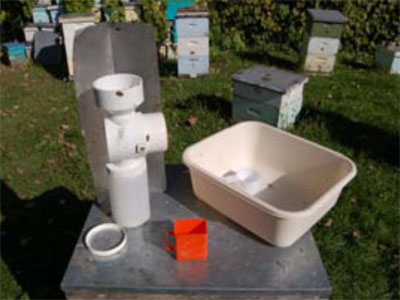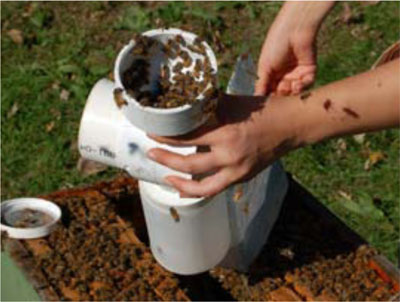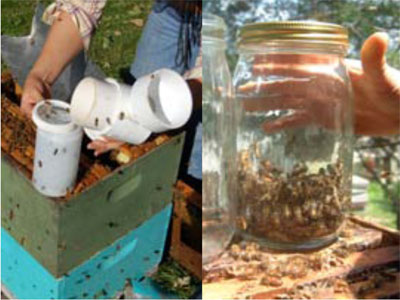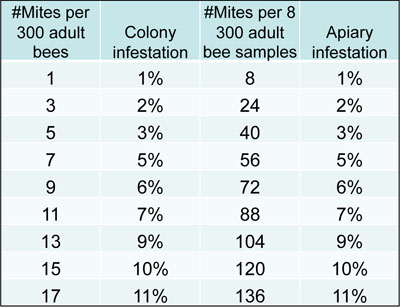Sampling for Varroa
Why SAMPLE in a standard way?
- Be informed: know thy enemy!
- Decrease use of miticides!
- Reduce chemical residues in hive!
- Save time and money!
- Develop regional treatment thresholds!
- Breed queens from colonies with low mites!

1. Sampling a Colony: Sample 300 adult
bees from one frame containing brood
(eggs, larvae or pupae).

2. 300 bees occupy a volume of 0.42 cup or
100 ml. Be careful! Bees are small, so
small changes in volume leads to large
changes in the number of bees (i.e. 0.33
cup = 200 bees, and 0.5 cup = 400 bees).

3. To make your own cup, add 0.42 cups or
100 ml of water to a cup. Mark a line at
the water. 0.42 cups = 1/3 cup + 1 tbsp
+1 1/14 tsp.

4. Use one of 3 methods to collect bees:
Method 1: Rap a brood frame into a
wash-bin bucket. Use your cup to scoop
out 300 bees. Rap cup on a hard surface
to be sure the bees are at the marked
line. Add or subtract bees as needed.

5. Method 2: If your cup is rectangular, run the
cup gently down the backs of the bees,
causing them to tumble into the cup. Rap
the cup on a hard surface to be sure the
volume of bees is at the marked line.

6. Method 3: Use the divice called “Gizmo”
to sample. It is available from the Walter
T Kelly Beekeeping Company or you can
build it using the plans online
(www.extension.umn.edu/honeybees).

7. Gizmo has a volume built in to measure
300 bees. Out of the three methods,
Gizmo is most accurate, but the other two
methods can work as well if the bees are
consistantly at the marked line.

8. Once the bees are measured, you can
use powdered sugar to dislodge the
mites. First, dump the 300 bees into a jar
with a size 8 hardware mesh cover.

9. Add about 2 Tbsp (one hive tool scoop)
of powdered sugar. Add more sugar if
the bees are not coated in white. Let the
bees set for at least one minute in the
shade. Don’t hurry this!

10. Shake the jar into a white dish for one
minute to dislodge mites from bees.
Shake HARD. It is important to remove
as many mites as possible. Replace the
sugar-coated bees bees in the colony
where they will be cleaned.

11. Add enough water to the dish to dissolve
the sugar. Count the mites. The mites
will be regular-shaped reddish-brown
ovals. You can sometimes see their legs
kicking.

12. Sampling an Apiary: Sample a total of
eight colonies using using one of the
methods described above. Sample every
fifth colony – loop back if need be.

13. Calculate: Convert mites per 300 bees to
percent infestation of the whole colony
(mites on adults plus those hidden in
pupae) by using this conversion chart or
formula [(mites/ 300 bees / 3) * 2].
If you are a hobby beekeeper,
consider treating at a 10-12% mite
infestation. If you are a commercial
beekeeper, you may want to use a
lower threshold.
For more information on how this
sampling procedure was derived and
treatment thresholds, please read the
article in American Bee Journal,
December 2010, or in J. Economic
Enotmology, 2010; vol 103(4): pp.
1039-1050.
